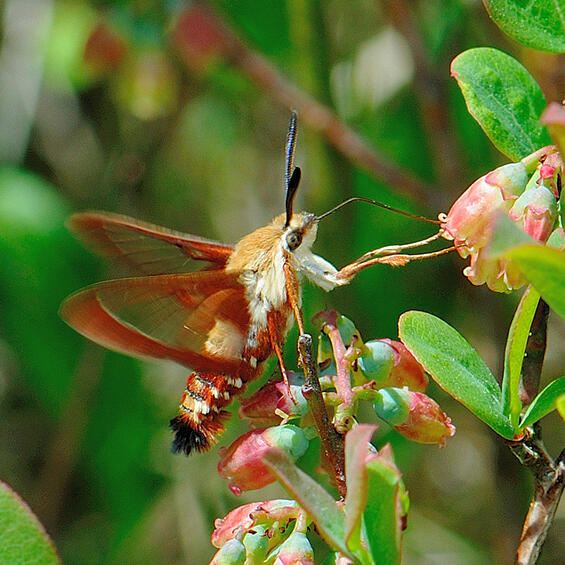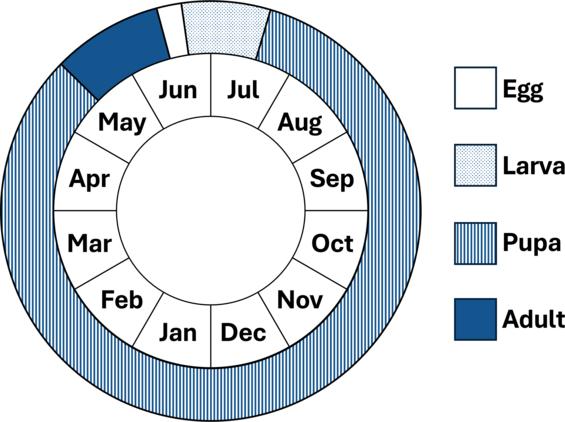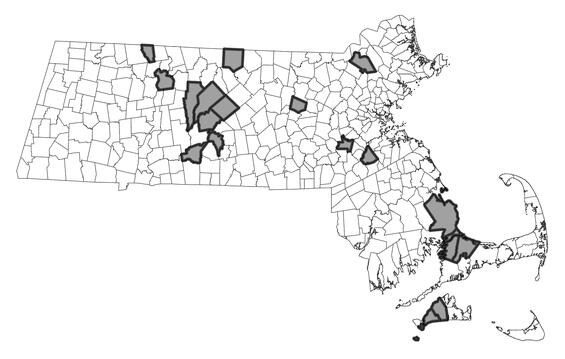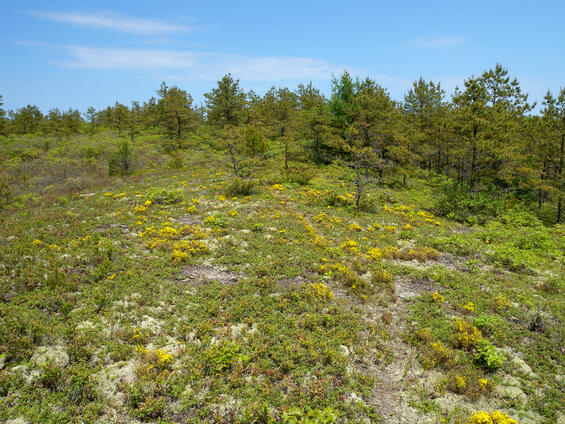- Scientific name: Hemaris gracilis
- Species of Greatest Conservation Need (MA State Wildlife Action Plan)
- Special Concern (MA Endangered Species Act)
Description

Slender clearwing sphinx moth, Hemaris gracilis.
The slender clearwing sphinx moth (Hemaris gracilis) is a day-flying moth in the family Sphingidae, with a wingspan of 40-45 mm (1.6-1.8 in; Covell 1984). Both the forewing and the hind wing are unscaled and transparent except for reddish-brown margins and narrow lines of the same color along the wing veins. Dorsally, the head and thorax are olive green in color when fresh, fading to yellowish-green; the abdomen is banded with green concolorous with the head and thorax, reddish-brown concolorous with the wings, black, and white. The tip of the abdomen has a brush of hair-like scales that are orange medially, flanked with black. Of the three day-flying sphinx moths (Hemaris spp.) in Massachusetts, the slender clearwing sphinx moth is most easily confused with the hummingbird clearwing (Hemaris thysbe). However, the slender clearwing sphinx moth has a lateral reddish-brown stripe on the thorax, extending from the eye to the abdomen (see photo), that is absent on the hummingbird clearwing.
Life cycle and behavior

In Massachusetts, the slender clearwing sphinx moth has a one-year life cycle, with the adult, day-flying moth active in May and June. The moth hovers to nectar at flowers much like a hummingbird. This species visits a variety of flowers, but especially blueberry (Vaccinium spp.). After mating, the female lays eggs on host plants, which for this species are primarily lowbush blueberry (Vaccinium pallidum and V. angustifolium), though possibly other species of blueberry as well. Like all moths and butterflies, adults die after mating and egg-laying. After hatching from the egg, the larva feeds on the host plant from June into July, then molting to a pupa in the leaf litter (NatureServe 2024). The pupa overwinters, emerging as an adult the following year.
Distribution and abundance
The slender clearwing sphinx moth is found from Labrador south to New Jersey, and west to Saskatchewan, North Dakota, Minnesota, and Illinois; it also occurs along the Atlantic coastal plain from New Jersey south to Florida (Tuttle 2007). It is rare and locally distributed throughout its range. In Massachusetts, the slender clearwing sphinx moth occurs primarily in southeastern Plymouth County and on Cape Cod and Martha’s Vineyard, as well as in northern and western Worcester County and Franklin County.

Distribution in Massachusetts.
2000-2025
Based on records in the Natural Heritage Database.
Habitat
The slender clearwing sphinx moth inhabits pitch pine-scrub oak barrens and heathlands on sandplains or rocky summits and ridges, as well as acidic bogs and swamps.
Healthy habitats are vital for supporting native wildlife and plants. Explore habitats and learn about conservation and restoration in Massachusetts.

Sandplain pitch pine-scrub oak barrens habitat with sparse trees and abundant lowbush blueberry, ideal habitat for the slender clearwing sphinx moth. Habitat managed by MassWildlife and DCR at Camp Cachalot WMA.
Threats
The slender clearwing sphinx moth is threatened by habitat loss and fire suppression in its disturbance-dependent habitats, in particular pitch pine-scrub oak barrens and heathlands on sandplains or rocky summits and ridges. Other potential threats include introduced generalist parasitoids, aerial insecticide spraying, non-target herbicide application, and off-road vehicles. The effect of a warming climate is difficult to predict for this species in Massachusetts. Its range extends south to Florida, suggesting adaptation to warm temperatures. However, some of its habitats, particularly acidic bogs and swamps, have a distinctively northern flora, and the persistence of these habitats (and their suitability for the slender clearwing sphinx moth) may be threatened by a warming climate.
Conservation
Land protection and habitat management are the primary conservation needs of this species in Massachusetts. In particular, pitch pine-scrub oak barrens and heathlands should be conserved, restored, and managed to maintain these habitats for this species and the entire suite of rare and threatened species dependent on them. Larger coastal areas of habitat, some already protected and managed, should be augmented with protection and management of similar inland habitats, to serve as “stepping stones” between coastal populations and those inhabiting inland sandplains, rocky summits, and acidic bogs and swamps.
Survey and monitoring
The distribution of the slender clearwing sphinx moth in both coastal and inland sandplain pitch pine-scrub oak barrens is well documented. Its occurrence on rocky summits and ridges with lowbush blueberries, as well as in acidic bogs and swamps, is less well documented, and additional surveys in such habitats are needed. Known populations of this species should be surveyed to document persistence at least once every 25 years; every 10 years is more desirable when practicable.
Management
Management of sandplain pitch pine-scrub oak barrens and heathlands benefits a suite of rare and threatened species, and habitat condition should be monitored and management adapted as needed. For the slender clearwing sphinx moth, open barrens and heathlands with a low shrub layer including lowbush blueberries (Vaccinium spp.) is of particular importance.
Research needs
The natural history and conservation needs of the slender clearwing sphinx are relatively well known as compared to most rare moths. While this species has a single primary brood in Massachusetts, it is capable of a second (Williams 1979). The second brood appears to be both partial and rare, possibly dependent on annual weather, but this has not been well studied. While lowbush blueberries (Vaccinium pallidum and V. angustifolium) are the main larval host plants in pitch pine-scrub oak barrens and heathlands, documentation of larval hosts in acidic bogs and swamps may add to the list of Vaccinium (or Ericaceae) fed upon.
References
Covell, C.V. 1984. A Field Guide to Moths of Eastern North America. Peterson Field Guide Series. Houghton Mifflin, Boston, Massachusetts. 496 pp.
NatureServe. 2024. NatureServe Network Biodiversity Data accessed through NatureServe Explorer [web application]. NatureServe, Arlington, Virginia. Available https://explorer.natureserve.org/. (Accessed: September 25, 2024).
Tuttle, J.P. 2007. The Hawk Moths of North America: A Natural History Study of the Sphingidae of the United States and Canada. Allen Press, Lawrence, Kansas. 253 pp.
Williams, B.D. 1979. Life history observations on Hemaris gracilis (Sphingidae). Journal of the Lepidopterists’ Society 33(4): 254 - 257.
Contact
| Date published: | March 7, 2025 |
|---|